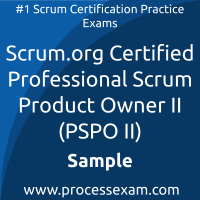01. Your stakeholders are very demanding and each of them has at least one feature that they say is essential for the next release. As the Product Owner, you have validated that the feature requests are all valid requests and would likely add value to your product. What should you do?
(Choose the best answer)
a) Wait until all essential features are complete before releasing the product.
b) Escalate to the steering committee to make the call.
c) Pick the two most influential stakeholders and satisfy their needs, then release.
d) Release when you can satisfy at least a single outcome, even though not all features are implemented.
02. Adaptation requires regular inspection. In what ways does the Product Owner contribute to the results achieved by inspection?
(choose the best two answers)
a) The Product Owner verifies the Sprint Backlog for completeness at the end of Sprint Planning in order to allow the Sprint to start.
b) The Product Owner shares the current state of Product Backlog at the Sprint Review, which, combined with the inspection of the Increment, leads to an updated Product Backlog.
c) The Product Owner invites stakeholders to the Sprint Review to learn how the current state of the marketplace influences what is the most valuable thing to do next.
d) The Product Owner inspects the Sprint burn-down at the Daily Scrum for progress towards a complete Increment and re-planning the team's work.
03. What should Developers do if the Product Owner is unavailable?
(choose the best answer)
a) Management should assign a substitute Product Owner to fill in when the Product Owner cannot be there.
b) Wait until the Product Owner is available again.
c) Ask the Product Owner’s manager to decide in the Product Owner’s absence.
d) Within the Sprint, the Developers make the best decisions possible to assure progress toward the Sprint Goal, re-aligning with the Product Owner once they are available again.
04. By which method an organization maximize the value that realize from the product over time?
(choose the best option)
a) Current Value Goal.
b) Unrealized Value goal.
c) Ability to Innovate.
d) Time to Market Goal.
05. Scrum Teams are self-managed and cross-functional. How does time-boxing promote self-management?
(choose the best two options)
a) Time-box does not allow enough time for stringent processes or meeting overhead.
b) Time-box eliminates complexity due to organizational hierarchy.
c) Time-box enables Scrum Team to determine the need for overtime as a percentage of the time-box.
d) Time-box helps everyone to focus on the same problem at the same time.
e) Time-box encourages team members closest to the problem to create the best possible solution in the allotted time
06. What is the Product Owner accountable for in Scrum?
(choose the best answer)
a) Maximizing the value of the product resulting from the work of the Scrum Team.
b) Describing an Increment at Sprint Planning and making sure that the Developers deliver it by the end of the Sprint.
c) Writing the User Stories so they are comprehensive enough for the stakeholders.
d) Refining the top level Product Backlog items until they are ready to be handed over to the Scrum Team.
07. Why Product Owner care about developers adhering to its Definition of Done?
(choose the best two options)
a) He doesn’t have to care. Other systems aren’t very good either.
b) To predict the team’s productivity over time.
c) To control the Total Cost of Ownership of the product.
d) To be able to reprimand the team when they don’t meet their velocity goal for the Sprint.
e) To have complete transparency into what has been done at the end of each Sprint.
08. How does an organization know that a product built using Scrum is successful?
(choose the best answer)
a) By the Product Owner and stakeholders accepting the Increment at the Sprint Review.
b) By measuring the actual time spent on development versus the time estimated for development.
c) By releasing frequently, and measuring the value customers/users experience.
d) By measuring that velocity has increased since the last release.
09. To what extent does technical debt limit the value a Product Owner can get from a product?
(choose the best two answers)
a) Technical debt is not a Product Owner concern, technical debt is only an issue for the Developers.
b) Technical debt causes a greater percentage of the product's budget to be spent on maintenance of the product.
c) Technical debt does not influence the delivery of value.
d) The velocity at which new functionality can be created is reduced when you have technical debt.
10. You have more ideas for new products than money to invest. what should you do?
a) Run proposals by market potentials (Unrealized Value) and fully fund as many as you can.
b) Fund small experiments to test the proposed ideas and assumptions, then evaluate results.
c) Invest in the proposals that have the highest projected current value for the next year.
d) Invest in all of them, but at proportionally lowered amounts, and see how they all perform.
 You have to pass the PSPO II exam to receive the certification from Scrum.org. To increase the effectiveness of your study and make you familiar with the actual exam pattern, we have prepared this Scrum.org Professional Scrum Product Owner sample questions. Our Sample Scrum.org Professional Scrum Product Owner II Practice Exam will give you more insight about both the type and the difficulty level of the questions on the Scrum.org PSPO 2 exam.
You have to pass the PSPO II exam to receive the certification from Scrum.org. To increase the effectiveness of your study and make you familiar with the actual exam pattern, we have prepared this Scrum.org Professional Scrum Product Owner sample questions. Our Sample Scrum.org Professional Scrum Product Owner II Practice Exam will give you more insight about both the type and the difficulty level of the questions on the Scrum.org PSPO 2 exam.